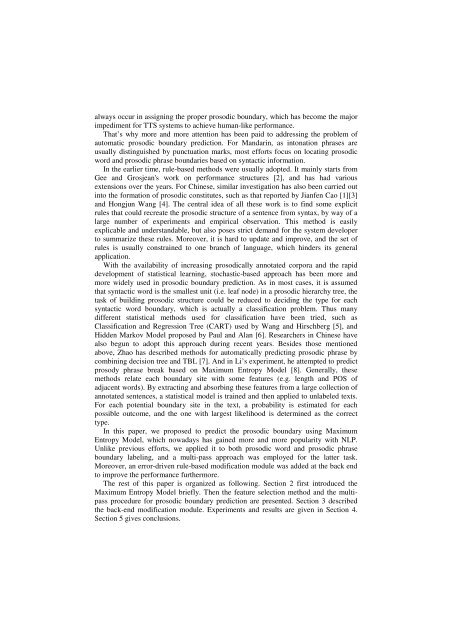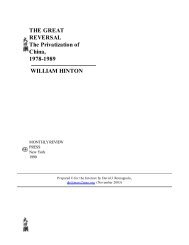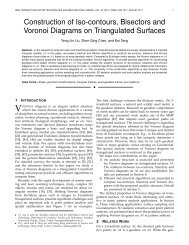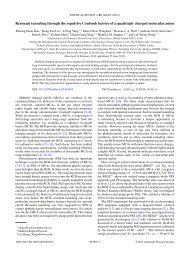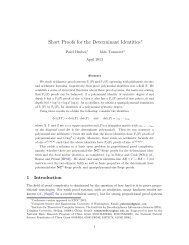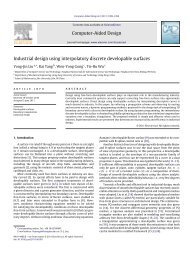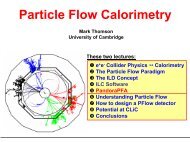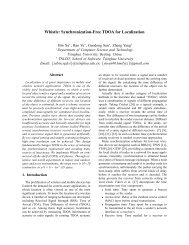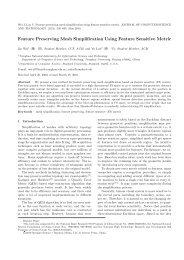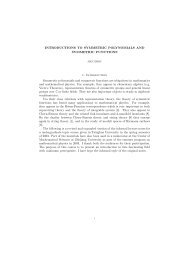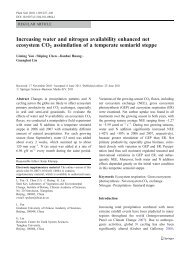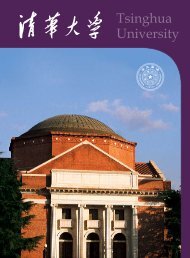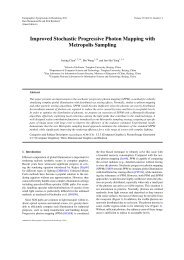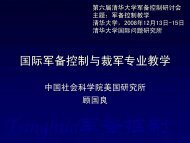Prosodic Boundary Prediction based on Maximum Entropy Model ...
Prosodic Boundary Prediction based on Maximum Entropy Model ...
Prosodic Boundary Prediction based on Maximum Entropy Model ...
Create successful ePaper yourself
Turn your PDF publications into a flip-book with our unique Google optimized e-Paper software.
always occur in assigning the proper prosodic boundary, which has become the major<br />
impediment for TTS systems to achieve human-like performance.<br />
That’s why more and more attenti<strong>on</strong> has been paid to addressing the problem of<br />
automatic prosodic boundary predicti<strong>on</strong>. For Mandarin, as int<strong>on</strong>ati<strong>on</strong> phrases are<br />
usually distinguished by punctuati<strong>on</strong> marks, most efforts focus <strong>on</strong> locating prosodic<br />
word and prosodic phrase boundaries <str<strong>on</strong>g>based</str<strong>on</strong>g> <strong>on</strong> syntactic informati<strong>on</strong>.<br />
In the earlier time, rule-<str<strong>on</strong>g>based</str<strong>on</strong>g> methods were usually adopted. It mainly starts from<br />
Gee and Grosjean's work <strong>on</strong> performance structures [2], and has had various<br />
extensi<strong>on</strong>s over the years. For Chinese, similar investigati<strong>on</strong> has also been carried out<br />
into the formati<strong>on</strong> of prosodic c<strong>on</strong>stitutes, such as that reported by Jianfen Cao [1][3]<br />
and H<strong>on</strong>gjun Wang [4]. The central idea of all these work is to find some explicit<br />
rules that could recreate the prosodic structure of a sentence from syntax, by way of a<br />
large number of experiments and empirical observati<strong>on</strong>. This method is easily<br />
explicable and understandable, but also poses strict demand for the system developer<br />
to summarize these rules. Moreover, it is hard to update and improve, and the set of<br />
rules is usually c<strong>on</strong>strained to <strong>on</strong>e branch of language, which hinders its general<br />
applicati<strong>on</strong>.<br />
With the availability of increasing prosodically annotated corpora and the rapid<br />
development of statistical learning, stochastic-<str<strong>on</strong>g>based</str<strong>on</strong>g> approach has been more and<br />
more widely used in prosodic boundary predicti<strong>on</strong>. As in most cases, it is assumed<br />
that syntactic word is the smallest unit (i.e. leaf node) in a prosodic hierarchy tree, the<br />
task of building prosodic structure could be reduced to deciding the type for each<br />
syntactic word boundary, which is actually a classificati<strong>on</strong> problem. Thus many<br />
different statistical methods used for classificati<strong>on</strong> have been tried, such as<br />
Classificati<strong>on</strong> and Regressi<strong>on</strong> Tree (CART) used by Wang and Hirschberg [5], and<br />
Hidden Markov <strong>Model</strong> proposed by Paul and Alan [6]. Researchers in Chinese have<br />
also begun to adopt this approach during recent years. Besides those menti<strong>on</strong>ed<br />
above, Zhao has described methods for automatically predicting prosodic phrase by<br />
combining decisi<strong>on</strong> tree and TBL [7]. And in Li’s experiment, he attempted to predict<br />
prosody phrase break <str<strong>on</strong>g>based</str<strong>on</strong>g> <strong>on</strong> <strong>Maximum</strong> <strong>Entropy</strong> <strong>Model</strong> [8]. Generally, these<br />
methods relate each boundary site with some features (e.g. length and POS of<br />
adjacent words). By extracting and absorbing these features from a large collecti<strong>on</strong> of<br />
annotated sentences, a statistical model is trained and then applied to unlabeled texts.<br />
For each potential boundary site in the text, a probability is estimated for each<br />
possible outcome, and the <strong>on</strong>e with largest likelihood is determined as the correct<br />
type.<br />
In this paper, we proposed to predict the prosodic boundary using <strong>Maximum</strong><br />
<strong>Entropy</strong> <strong>Model</strong>, which nowadays has gained more and more popularity with NLP.<br />
Unlike previous efforts, we applied it to both prosodic word and prosodic phrase<br />
boundary labeling, and a multi-pass approach was employed for the latter task.<br />
Moreover, an error-driven rule-<str<strong>on</strong>g>based</str<strong>on</strong>g> modificati<strong>on</strong> module was added at the back end<br />
to improve the performance furthermore.<br />
The rest of this paper is organized as following. Secti<strong>on</strong> 2 first introduced the<br />
<strong>Maximum</strong> <strong>Entropy</strong> <strong>Model</strong> briefly. Then the feature selecti<strong>on</strong> method and the multipass<br />
procedure for prosodic boundary predicti<strong>on</strong> are presented. Secti<strong>on</strong> 3 described<br />
the back-end modificati<strong>on</strong> module. Experiments and results are given in Secti<strong>on</strong> 4.<br />
Secti<strong>on</strong> 5 gives c<strong>on</strong>clusi<strong>on</strong>s.


